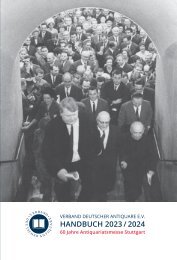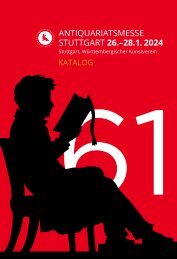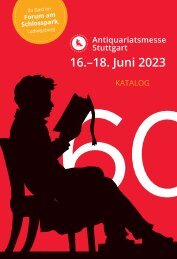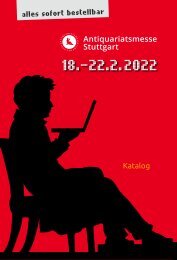Antiquariatsmesse Stuttgart 2021 - Katalog
Katalog zur Antiquariatsmesse Stuttgart 2021: Die Antiquariatsmesse Stuttgart als größtes Schaufenster für wertvolle Objekte des Antiquariats- und Graphikhandels in Deutschland findet in diesem Jahr in ungewohnter Form statt. Da eine Präsenzmesse nicht stattfinden kann, haben sich 76 Kollegen aus Deutschland, Großbritannien, Österreich, Frankreich, der Schweiz, den Niederlanden, den Vereinigten Staaten und aus Australien zusammengefunden, um einen Katalog für die Messe zu erstellen und gleichzeitig ein Angebot für eine virtuelle Messe zusammengetragen. Der Katalog wird am 7. Januar 2021 an interessierte Kunden verschickt, die virtuelle Messe öffnet ihre „digitalen Pforten“ am 29. Januar 2021 um 12.00 Uhr unter www.antiquariatsmesse-stuttgart.de
Katalog zur Antiquariatsmesse Stuttgart 2021: Die Antiquariatsmesse Stuttgart als größtes Schaufenster für wertvolle Objekte des Antiquariats- und Graphikhandels in Deutschland findet in diesem Jahr in ungewohnter Form statt. Da eine Präsenzmesse nicht stattfinden kann, haben sich 76 Kollegen aus Deutschland, Großbritannien, Österreich, Frankreich, der Schweiz, den Niederlanden, den Vereinigten Staaten und aus Australien zusammengefunden, um einen Katalog für die Messe zu erstellen und gleichzeitig ein Angebot für eine virtuelle Messe zusammengetragen.
Der Katalog wird am 7. Januar 2021 an interessierte Kunden verschickt, die virtuelle Messe öffnet ihre „digitalen Pforten“ am 29. Januar 2021 um 12.00 Uhr unter www.antiquariatsmesse-stuttgart.de
Erfolgreiche ePaper selbst erstellen
Machen Sie aus Ihren PDF Publikationen ein blätterbares Flipbook mit unserer einzigartigen Google optimierten e-Paper Software.
Rhein … Zu München, sechzehenhundert und
dreyzehenden Jahr/ den zwölfften Novembris Celebriert
und gehalten. 5 pp. Text and 6 double-page
Plates. Augspurg: Wilhelm Peter Zimmermann,
1614. € 15000,–
Beautifully printed De Bry edition of Perret’s remarkable
book, which is comprised of plates and text dealing
with imaginary fortifications and city plans. The most
extraordinary aspect of the engravings centers on the
surreal quality of the fortifications and the visionary
designs of the buildings, including one thirteen-story
edifice, complete with rooftop sculptures, urns and
fountains, which prefigures the modern urban skyscraper.
– The Festival book lacks the title, dedication
and plates 6–10.
For Perret, OCLC lists only the Art Institute of Chicago,
Universities of Minnesota and Pennsylvania in
the US, and for Brunn it lists 9 copies. Only NYPL
for the Festival book. There are no listings in OCLC
for the Solis.
Antolini, Giovanni Antonio. Projetto sul Foro
Bonaparte che doveva Eseguirsi in Milano in 24
Gran Tavole. Title-page and suite of twenty-four
plates, comprising 14 magnificent double-page aquatint
views printed in shades of sepia ink and 10
double-page engraved floor-plans and scaled architectural
drawings. Large folio, 572 × 440 mm, bound
in full contemporary Italian boards. Milan: Bettalli,
ND [1814]. € 30000,–
A splendid copy of these magnificent plates. These
grand aquatint views document an imposing project
that was never constructed and never proceeded beyond
the publication of various issues of these plates.
The scale and design of the buildings and plazas evoke
the visionary work of Antolini’s celebrated contemporaries:
Claude-Nicolas Ledoux and Etienne-Louis
Boullée. Antolini provided the drawings for all the
plates except one, which was executed by Alessandro
Sanquirico; the engravings were cut by Fernando Albertolli,
Filippo Antolini, Giuseppe Cariani and others.
Our version, the last published, of Antolini’s work was
issued by the firm of Fratelli Betalli in 1814, entitled:
„Progetto sul Foro che doveva eseguirsi in Milano: in
24 Tavole in Rame/ del Architetto Professore Giovanni
Antolini.“ None of the copies of this publication which
are recorded in RLIN and OCLC contains any text. In
consulting with the Getty Institute (which has copies
of both re-issued versions: the Bodoni & the Fratelli
Betalli), it seems likely that the Fratelli Betalli publication
is, in fact, a remainder issue of the original aquatint
plates printed in Milan 1801–04!
All versions of these spectacular plates are extremely
rare. OCLC records copies only at the National Gallery,
CCA, Columbia, and the Getty.
Tomatsu Masanori, Muneyasu Kageyama et
al. Edo Kiriezu. A complete set of 31 Coloured
Woodblock Maps of Tokyo. 12mo., each bound
in original pale blue wrappers, preserved in a contemporary
wooden box. Edo: Owariya Seishichi,
1852–1864. € 20000,–
A possibly unique set of these Tokyo maps consisting of
a mix of the First and Revised Editions, but containing
an unrecorded 31st part. This part covered the Hacchobori
district which was composed of the security
administration; police, judge, defense, sheriff, etc. This
colourful series of late Edo period maps depicts Tokyo’s
wards and the buildings, temples, shrines, gardens and
residences therein. These maps represent not only a
fine example of woodblock printing, but also remain an
indispensable source of information on the architecture
of Tokagawa Edo.
The most important structures are illustrated with
rough, yet charming depictions of the actual buildings,
often surrounded by images of trees and gardens. Some
of these structures include: The Hie Shrine (lost to
bombing in the Second World War); Kanei-ji Temple,
burial sight of 6 Tokagawa Shoguns; Senso-ji Temple,
the oldest temple in Tokyo; Hamagoten Garden, the
villa of the Tokugawa family, and many others.
A complete list of each map’s creator, title, size and
publication date is available upon request.
Ernst, Max. Mr. Knife and Mrs. Fork. Text by René
Crevel, translated by Kay Boyle. With 19 photograms
of frottages by Max Ernst. 8vo., original full
black cloth, elaborately gilt and embossed designed
by Ernst on covers, in a sleeve and slipcase by Leroux.
Paris: The Black Sun Press, 1931. € 17 500,–
A celebrated and rare surrealist collaboration. This is
one of 200 copies on „finest Bristol paper“. The nineteen
photograms illustrating the book were produced
from Max Ernst’s frottages, created by rubbing translucent
paper on top of a textured surface/image. Using
this „impression“ on the special paper, Ernst then shot
light through the thin paper onto photosensitive paper
underneath, creating a type of photographic negative.
These were then reproduced in the form of negative
photograms with the assistance of Man Ray. A superb
copy with the frontispiece signed by Max Ernst.
Dalí, Salvador. Les Chants de Maldoror. By Comte
de Lautréamont, (Isidore Ducasse). 208, [4] pp.
Illustrated with 42 original etchings by Dalí, of
which 30 are full page hors-texte plates, printed
by Lacourière. Folio, 318 × 243 mm, bound in full
dark blue morocco by Devauchelle, preserved in
a matching slipcase. Paris: Albert Skira Editeur,
1934. € 45000,–
A fine copy of Dalí’s masterpiece as a book-illustrator,
and one of the major monuments of twentieth-century
book-illustration.
It was Picasso who suggested that Dalí should illustrate
the book, which was one of the key texts that inspired
the Surrealists. Encouraged by Skira, Dalí began his
preliminary sketches in 1932, and it took two years until
the work was completed. Although the edition was
announced as 210 copies, probably only half of them
were ever issued. „Dalí’s first original book illustrations
289






